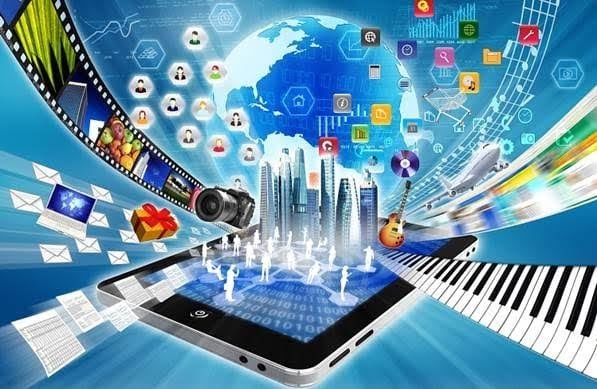Multimedia uses computers to present text, audio, video, animation, interactive features, and still images in various ways and combinations made possible through the advancement of technology. By combining media and content, those interested in multimedia can take on and work with a variety of media forms to get their content across. This is an exciting new field for those interested in computers, technology, and creative career options. Multimedia can be accessed through computers or electronic devices and integrates the various forms together. One example of multimedia would be combining a website with video, audio, or text images.
Examples of typical multimedia applications include: digital video editing and production systems; electronic newspapers and magazines; the World Wide Web; online reference works, such as encyclopedias; games; groupware; home shopping; interactive TV; multimedia courseware; video conferencing; video – on – demand; and interactive movies.
Components of Multimedia
The multiple modalities of text, audio, images, drawings, animation, and video in multimedia are put to use in ways as diverse as
· Video teleconferencing
· Distributed lectures for higher education
· Telemedicine
· Cooperative work environments that allow business people to edit a shared document or school children to share a single game using two mice that pass control back and forth
· Searching (very) large video and image databases for target visual objects
· “Augmented” reality: placing real appearing computer graphics and video objects into scenes so as to take the physics of objects and lights (e.g., shadows) into account
· Audio cues for where video – conference participants are seated, as well as taking into account gaze direction and attention of participants
· Building searchable features into new video and enabling very high to very low bitrate use of new, scalable multimedia products
· Making multimedia components editable — allowing the user side to decide what components, video, graphics, and so on are actually viewed and allowing the client to move components around or delete them -— making components distributed
· Building “inverse – Hollywood” applications that can recreate the process by which a video was made, allowing storyboard pruning and concise video summarization.
· Using voice recognition to build an interactive environment —- say a kitchenwall web browser
From the computer science student’s point of view, what makes multimedia interesting is that so much of the material covered in traditional computer science areas bears on the multimedia enterprise: networks, operating systems, real – time systems, vision, information retrieval. Like databases, multimedia touches on many traditional areas.
Multimedia Research Topics and Projects
To the computer science researcher, multimedia consists of a wide variety of topic:
· Multimedia processing and coding. This includes multimedia content analysis, content – based multimedia retrieval, multimedia security, audio / image / video processing, compression, and so on.
· Multimedia system support and networking.People look at such topics as network protocols, Internet, operating systems, servers and clients, quality of service (QoS), and databases.
· Multimedia tools, end systems, and applications. These include hypermedia systems, user interfaces, authoring systems, multimodal interaction, and integration: “ubiquity” — web – everywhere devices, multimedia education, including computer supported collaborative learning and design, and applications of virtual environments.
The concerns of multimedia researchers also impact researchers in almost every other branch of computer science. For example, data mining is an important current research area, and a large database of multimedia data objects is a good example of just what we may be interested in mining. Telemedicine applications, such as “telemedical patient consultative encounters,” are multimedia applications that place a heavy burden on existing network architectures.
Current Multimedia Projects Many exciting research projects are currently underway in multimedia, and we’d like to introduce a few of them here.
For example, researchers are interested in camera – based object tracking technology. One aim is to develop control systems for industrial control, gaming, and so on that rely on moving scale models (toys) around a real environment (a board game, say). Tracking the control objects (toys) provides user control of the process.
3D motion capture can also be used for multiple actor capture, so that multiple real actors in a virtual studio can be used to automatically produce realistic animated models with natural movement.
Multiple views from several cameras or from a single camera under differing lighting can accurately acquire data that gives both the shape and surface properties of materials, thus automatically generating synthetic graphics models. This allows photo – realistic (video – quality) synthesis of virtual actors.
3D capture technology is next to fast enough now to allow acquiring dynamic characteristics of human facial expression during speech, to synthesize highly realistic facial animation from speech.
Multimedia applications aimed at handicapped persons, particularly those with poor vision and the elderly, are a rich field of endeavor in current research.
“Digital fashion” aims to develop smart clothing that can communicate with other such enhanced clothing using wireless communication, so as to artificially enhance human interaction in a social setting. The vision here is to use technology to allow individuals to allow certain thoughts and feelings to be broadcast automatically, for exchange with others equipped with similar technology.
Georgia Tech’s Electronic Housecall system, an initiative for providing interactive health monitoring services to patients in their homes, relies on networks for delivery, challenging current capabilities.
Behavioral science models can be brought into play to model interaction between people, which can then be extended to enable natural interaction by virtual characters. Such “augmented interaction” applications can be used to develop interfaces between real and virtual humans for tasks such as augmented storytelling.
Each of these application areas pushes the development of computer science generally, stimulates new applications, and fascinates practitioners.
History of Multimedia
The term “multimedia” was coined by singer and artist Bob Goldstein (later ‘Bobb Goldsteinn’) to promote the July 1966 opening of his “LightWorks at L’Oursin” show at Southampton, Long Island. Goldstein was perhaps aware of a British artist named Dick Higgins, who had two years previously discussed a new approach to art – making he called “intermedia.”
On August 10, 1966, Richard Albarino of Variety borrowed the terminology, reporting: “Brainchild of songscribe – comic Bob (‘Washington Square’) Goldstein, the ‘Lightworks’ is the latest multi – media music – cum – visuals to debut as discothèque fare. ”Two years later, in 1968, the term “multimedia” was re – appropriated to describe the work of a political consultant, David Sawyer, the husband of Iris Sawyer — one of Goldstein’s producers at L’Oursin.
In the intervening forty years, the word has taken on different meanings. In the late 1970s the term was used to describe presentations consisting of multi – projector slide shows timed to an audio track. However, by the 1990s ‘multimedia’ took on its current meaning.
In the 1993 first edition of McGraw – Hill’s Multimedia: Making It Work, Tay Vaughan declared “Multimedia is any combination of text, graphic art, sound, animation, and video that is delivered by computer. When you allow the user – the viewer of the project – to control what and when these elements are delivered, it is interactive multimedia. When you provide a structure of linked elements through which the user can navigate, interactive multimedia becomes hypermedia.”
The German language society, Gesellschaft für deutsche Sprache, decided to recognize the word’s significance and ubiquitousness in the 1990s by awarding it the title of ‘Word of the Year’ in 1995. The institute summed up its rationale by stating “[Multimedia] has become a central word in the wonderful new media world”
In common usage, the term multimedia refers to an electronically delivered combination of media including video, still images, audio, text in such a way that can be accessed interactively. Much of the content on the web today falls within this definition as understood by millions. Some computers which were marketed in the 1990s were called “multimedia” computers because they incorporated a CD – ROM drive, which allowed for the delivery of several hundred megabytes of video, picture, and audio data. That era saw also a boost in the production of educational multimedia application CD – ROMs.


